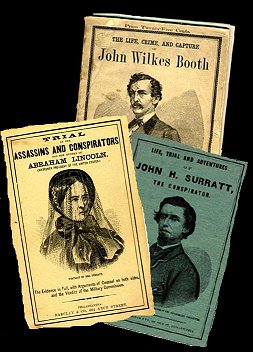THE 1865 LINCOLN ASSASSINATION CONSPIRACY TRIAL
|
John Wilkes Booth, an actor, was a 26-year-old Confederate sympathizer and racist. Originally his plan was to kidnap President Abraham Lincoln, but later his plans turned to murder.
Pictured to the right are the covers of some very old booklets. An anonymous donor graciously contributed the image of the booklets to this website.
Booth planned to assassinate Abraham Lincoln, Vice-President Andrew Johnson, Secretary of State William Seward, and General Ulysses S. Grant. Booth was out for revenge, and he thought creating chaos in the federal government might lead to a comeback for the Confederacy. The Grants declined the Lincolns' theater invitation; thus Ulysses' life was spared. No attempt was made on Johnson's life. Seward was brutally attacked in his home, but he survived. Only Lincoln died. Booth, himself, never went to trial because he was killed while being captured.
|
|
|
|
 |
After the assassination the government arrested several hundred people. Most were soon released due to lack of evidence. However, the government did charge eight people with conspiracy. On May 1, 1865, President Andrew Johnson ordered the formation of a military commission to try the accused persons. The actual trial began on May 10th and lasted until June 30th. It took place on the third floor of the Old Arsenal Penitentiary (nowadays on the grounds of Fort Lesley J. McNair). Judge Advocate General Joseph Holt of the United States Army presided. The defendants were allowed to have lawyers and witnesses, but they were not allowed to testify themselves. To read the actual testimony of the trial, CLICK HERE. For MUCH more information on the Lincoln Conspiracy Trial, CLICK HERE. Included on this page are brief outlines of what happened to those eight defendants. |
|
|
The Military Commission

(Left to right) Lieutenant Colonel David R. Clendenin, Brevet Colonel C.H. Tompkins, Brigadier General T.M. Harris, Brigadier General Albion P. Howe, Brevet Brigadier General James A. Ekin, Major General Lew Wallace, Major General David Hunter, Brevet Major General August V. Kautz, Brigadier General Robert S. Foster, the Honorable John A Bingham (Special Judge Advocate), Colonel Henry L. Burnett (Special Judge Advocate), and Brigadier General Joseph Holt (Judge Advocate and Recorder). The photograph is from the Library of Congress.


|
|
Lewis Thornton Powell, also known as Lewis Paine or Payne, was charged with conspiracy and the attempted assassination of Secretary of State William Seward. Powell entered Seward's home the night of Lincoln's assassination. He knifed and pistol-whipped five people in the house. Luckily, all survived his brutality. Powell was found guilty by the court and was hanged on July 7, 1865.
|
|
Herold was charged with conspiracy and assisting Booth during his 12 days on the run after the assassination. When Booth and Herold were surrounded in a barn at Garrett's farm in Virginia, Herold gave up. He was found guilty and hanged on July 7, 1865.
|
|
Atzerodt was charged with conspiring with Booth; his assignment was to kill Vice-President Andrew Johnson. Atzerodt rented a room in the Kirkwood House, the vice-president's hotel, and directed a series of "suspicious" questions to the hotel's bartender. He made no attempt to kill Johnson. Nevertheless, he was found guilty and hanged on July 7, 1865.
|
|
Mary Surratt, boardinghouse owner, was charged with conspiring with Booth, "keeping the nest that hatched the egg," and running errands for Booth that facilitated his escape. It was alleged that Booth used her boardinghouse to meet with his co-conspirators. Mrs. Surratt was found guilty and was hanged on July 7, 1865.
|
|
Dr. Samuel Mudd was charged with conspiring with Booth and with aiding the semi-crippled assassin during his escape by sheltering him and setting his broken left leg. Mudd was found guilty and sentenced to life. However, he received a pardon from President Andrew Johnson in February of 1869. He returned to his home in Maryland and lived there until his death from pneumonia on January 10th, 1883.
|
|
Arnold was charged with being part of Booth's earlier plot to kidnap President Lincoln. He was found guilty and sentenced to life. Like Dr. Mudd, he was pardoned by Andrew Johnson early in 1869. He lived until 1906.
|
|
Like Arnold, O'Laughlen was charged with conspiracy to kidnap the president. He was found guilty and sentenced to life. He died of yellow fever in prison at Ft. Jefferson on September 23, 1867.
|
|
Spangler was charged with helping Booth escape from Ford's Theatre immediately after the assassination. Spangler was found guilty and sentenced to six years in prison. He was pardoned by President Andrew Johnson in 1869. He worked for John Ford in Baltimore until 1873. He traveled to Dr. Mudd's home and lived on some land the doctor gave him until his death on February 7, 1875.
|
|
|




